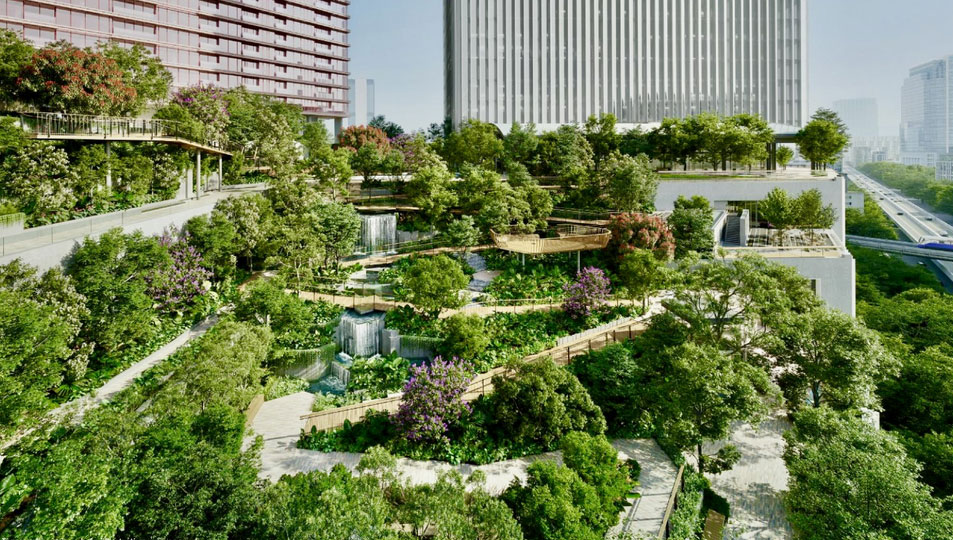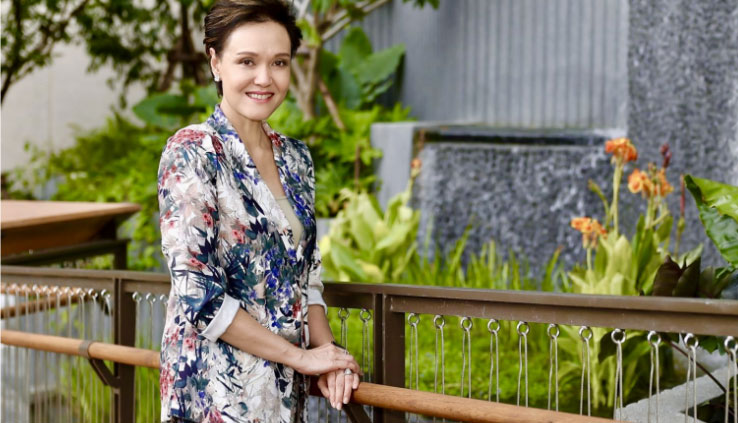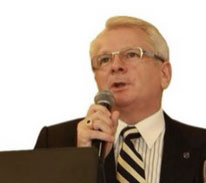BANGKOK, 22 August 2025: Thailand’s capital is a city of surprises. When you think you’ve seen it all, from the labyrinth of street food stalls to glistening temple spires, a bold, green vision emerges above the skyline.
Enter the new seven-rai rooftop garden at Bangkok’s Dusit Central Park, now the largest of its kind in the country. Floating high above the historic Silom district, this urban oasis isn’t just a pretty patch of green; it’s a powerful symbol of what Bangkok could be: Liveable, breathable, and beautifully rebalanced.

Set across the 4th to the 7th floors of the mixed-use development, this 11,200-sqm sanctuary opens to the public on 3 September 2025. And for those of us who’ve long lamented the city’s concrete sprawl, this is welcome news indeed.

A garden with a mission
Developed by Vimarn Suriya Co, the garden is part of the ambitious THB46-billion Dusit Central Park project, an integrated retail, office, hotel and residential hub. But what sets this rooftop retreat apart is not its scale, but its soul.
The garden is planted exclusively with native Thai flora, carefully selected for high oxygen output and carbon absorption. Add to that wheelchair-friendly ramps, waterfall features, QR-coded educational zones, and shaded walkways, and you have more than a garden; you have a space designed with intention, inclusivity, and impact.

Suphajee proudly declares that the garden’s concept follows “Universal Design” principles, ensuring accessibility for all. But what struck me most was the garden’s ethos. Here, we see not just a nod to environmentalism, but a deep-rooted attempt to bring life, human, plant and cultural, back to the city centre.
Greening a greedy city
Bangkok has never been known for generous green space. At last count, the average Bangkokian had access to just 3.3 sqm of public greenery. Compare that with Singapore’s whopping 66 sqm per person, and the contrast is stark.
It wasn’t always this way. Silom, where this garden now crowns a modern skyline, was once a bustling commercial and social hub. Over the years, however, it lost ground to hipper, glossier districts like Sukhumvit and Thonglor. Office towers emptied, shoppers scattered, and the pulse of the neighbourhood dimmed. But with the new rooftop garden as its crown jewel, there’s hope that Silom’s heart might beat strong again.
Lessons from the neighbours
The visuals offer a glimpse of the design brief. I couldn’t help but think of Singapore and how its iconic Gardens by the Bay transformed not just the city’s waterfront, but its mindset. Today, the city-state is the poster child for green urbanism. Trees aren’t an afterthought; they are a design philosophy.
Closer to nature (and to my heart), the Kingdom of Bhutan offers another lesson. With over 70% of its land covered in forest, Bhutan isn’t merely protecting its landscape; it’s nurturing its identity. Recent developments in southern Bhutan have shown how even new urban areas can be planned around nature, not over it. The Kingdom of Bhutan, world-renowned for creating the concept of Gross National Happiness (GNH) and for being the first carbon-negative country, is now launching the Gelephu Mindfulness City, an interconnected bridge of sustainable development between South and Southeast Asia.
Of course, Bangkok could never reach Bhutan’s astonishing forest ratio, but that’s not the point. What we can borrow is the principle: That quality of life, not just commerce or concrete, should guide city planning.
If I were a city planner
Bangkok is my adopted home. Since arriving in 1991, I’ve watched it rise, sprawl and shift. I’ve celebrated its dynamism and, at times, sighed at its chaos. So if I were granted a day in the shoes of a city planner, I’d start with three words: Trees, water, lawns. As big and expansive as possible, like Central Park in New York or Hyde Park in London. I miss grass. To stroll, jog or play ball/exercise. I miss the smell and the softness underfoot. Imagine a city where every neighbourhood had its own pocket park or rooftop garden, where shaded walking paths and canals (our unloved klongs) linked one green space to the next, where food stalls and family-friendly playgrounds are nestled beside lotus ponds, where Bangkok’s millions didn’t have to flee to Lumpini or Chatuchak to find grass beneath their feet.
We need to think vertically, but also horizontally. Let’s create corridors of green that slice through the grey. And let’s not forget the water. Our rivers and canals, so often neglected, could be turned into vibrant urban features. Floating gardens, pedestrian-friendly embankments, or amphitheatres by the water. These are not utopian dreams. They are practical possibilities, drawn from cities that dared to rethink their relationship with space.
Planting Seeds of Change
The challenge is clear: Bangkok has more cars than residents, relentless development pressure, and a climate that demands shade, not shadeless skyscrapers.
Bangkok will soon have a model on the Dusit rooftops: a space that blends nature, accessibility, culture and calm. And we now have the Bangkok Metropolitan Administration (BMA) showing increasing willingness to innovate.
The next step? Make it policy. Introduce green building incentives, mandate rooftop gardens for significant developments, and expand school and hospital gardens. Let’s make greenery not a luxury, but a civic right.
The new rooftop garden is more than a park. It is a signal that Bangkok is listening, taking account of its people, its past and its potential. It offers a high-up haven in a city that too often forgets to look up, to breathe, to rest.
If we treat it not as an isolated success but as a springboard for broader change, then perhaps we are not just planting trees. We are planting a future: One leaf, one path, one cool shady bench at a time.

About the author
Andrew J Wood is a respected travel writer, hotelier, and tourism lecturer with over four decades of experience in Southeast Asia’s hospitality and tourism sectors. A former general manager of several leading hotels in Thailand, Andrew arrived here in 1991 with the Shangri-La Hotel Bangkok and has remained in Thailand ever since. He has worked with Royal Garden Resorts (now Anantara) and the Landmark Group of Hotels. He has served as General Manager at the Royal Cliff Group and Chaophya Park Hotels & Resorts. He is a past president of Skål International Asia, Thailand’s National President, and a two-time Past President of Skål International Bangkok. Andrew contributes regularly to leading regional and global travel publications and remains a passionate advocate for sustainable, people-focused tourism.






